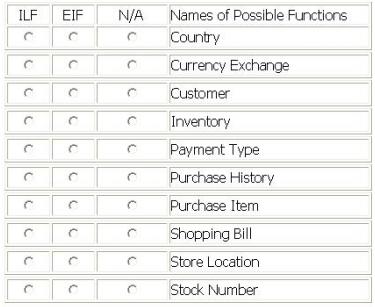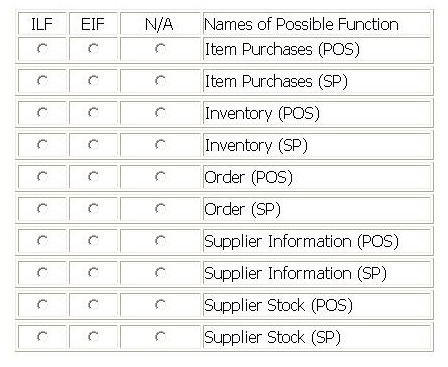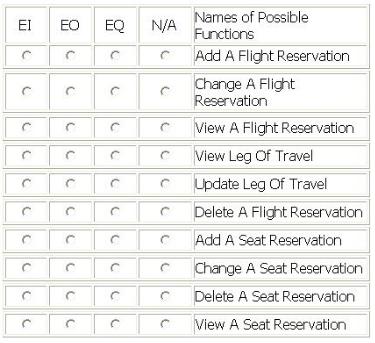IFPUG I40-420 - Certified Function Point Specialist
Several data functions are described in the scenario for the Internet Application (IA):
The user may query store locations where an order can be picked up. The Store Location logical file is updated in the IA as new locations open
The user may pay their internet shopping bill using the purchase item option. This option updates the Customer logical file with the date of purchase, the Inventory logical file with stock number and quantity, and Purchase History logical file with date, stock number, price and discounts applied.
Prior to the completion of the purchase item option the purchase amount is converted from US dollars into the user' s local currency. The currency conversion requires reference data from the Currency Exchange logical file, which Is maintained through the Financial application. The Currency Exchange file is updated daily. The payment code is used to determine how the payment will be made.
If this is the user's first purchase, customer Information is added to the Customer logical file. As part of adding customer information the Country file is referenced in order to store country code in the Customer logical file rather than country name.
From the Names of Possible Functions listed identify the data functions for the IA. Select N/A if a Name of Possible Function does not apply.
Identify the data functions used:

The Procurement application user requires the ability to control how and when reports are printed. The following list shows the specific user requirements for generating reports:
Display a list of reports that are available to be printed.
The user selects a report to be printed. If report control information exists for the requested report, the report control is displayed from the Report Control logical file.
If report control information has not been specified for the requested report, the user may add the following report controls:
report id
sort sequence
printer port
whether or not to generate a microfiche copy
whether or not to generate a paper copy
If report control information exists for the requested report, the user may update or delete the report controls.
From the Names of Possible Functions listed identify the transactional functions for the Procurement application. Select N/A if a Name of Possible Function does not apply.
Identify the functions used:

The Stock Purchasing (SP) and Point of Sale (POS) applications have the following requirements.
The POS application maintains details of customer purchases in the Item Purchases logical file.
The SP application is used to place orders with suppliers based on daily inventory levels.
The SP application is used to maintain supplier information. The Supplier Information logical file contains descriptions of items the supplier stocks and supplier contact information.
The Inventory logical file is maintained by the SP application through a daily batch process which references the Item Purchases logical file.
When the batch process is complete, the SP application displays a list of items that are below 20% of normal inventory levels. The user selects items to be ordered and specifies the supplier. The SP application then generates a purchase order for each supplier. The purchase orders are sent electronically to each supplier and stored in the Order logical file.
From the Names of Possible Functions listed identify the data function both the SP and POS applications. Select N/A if a Name of Possible Function does not apply.
Identify the functions used:

A Flight Reservation application has the ability to make a reservation and reserve a seat.
A passenger calls to make a reservation. The booking agent adds the information into the Flight Reservation logical file.
At a later time the passenger can make a change to the reservation through the booking agent.
The booking agent views the flight reservation record before changing it.
The booking agent can also reserve a seat for the passenger for each leg of his travel, but cannot change or delete the seat reservation once made. Seat reservations are stored in the Seat Reservation logical file.
The booking agent can view the seat reservation record.
From the Names of Possible Functions listed identify the transactional functions for the Flight Reservation application. Select N/A if a Name of Possible Functions does not apply.
Identify the functions used:








